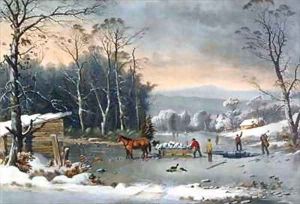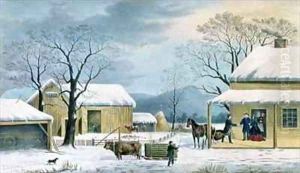Durrie, George Paintings
George Henry Durrie was an American painter born on June 6, 1820, in Hartford, Connecticut. He is best known for his rural winter scenes, which have become iconic images of 19th-century American life, often associated with the holidays and the idea of an idyllic countryside. Durrie's paintings typically feature New England landscapes, and his work has been celebrated for its detailed and tranquil depiction of the American Northeast.
Durrie's interest in art began at a young age, and he initially trained with a local engraver. By his early twenties, he had decided to pursue painting full-time and opened his own studio in New Haven, Connecticut. During the 1840s, Durrie traveled and worked in the United States, developing his skills and seeking to establish himself as an artist. However, it wasn't until the 1850s that he began to receive significant recognition for his work.
George Henry Durrie's career was given a considerable boost when his paintings were reproduced as lithographs by the firm of Currier and Ives, making his images widely accessible and popular throughout the country. These reproductions played a crucial role in shaping the American public's visual understanding of winter in the countryside and contributed to Durrie's posthumous fame. Among his most notable works are 'Hunter in Winter Wood' and 'Farmyard in Winter,' which are exemplary of his skill in capturing the serene and harmonious aspects of snowy landscapes.
Tragically, Durrie's career was cut short when he died on October 15, 1863, at the age of 43, in New Haven. Despite his relatively brief career, Durrie's work had a lasting impact and continues to be appreciated for its nostalgic and picturesque portrayal of rural America. His paintings are held in numerous collections and have been featured in various exhibitions dedicated to American art of the 19th century.

